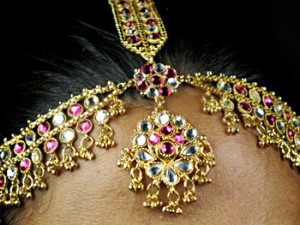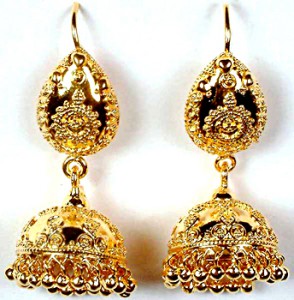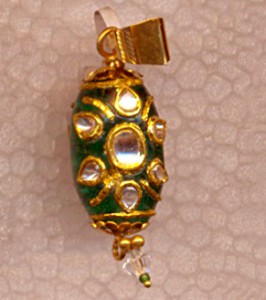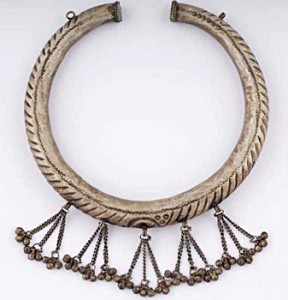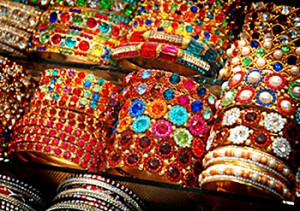Jewellery for Women in Rajasthan
 Jewellery for women in Rajasthan plays a vital role in their lifestyle. The Rajasthani jewelleries are a part of the daily ornamentation and a mark to describe their present status as well. The traditional pieces of jewellery in Rajasthan and strictly followed according to status of the person, adorning the woman`s complete figure from head to toe.
Jewellery for women in Rajasthan plays a vital role in their lifestyle. The Rajasthani jewelleries are a part of the daily ornamentation and a mark to describe their present status as well. The traditional pieces of jewellery in Rajasthan and strictly followed according to status of the person, adorning the woman`s complete figure from head to toe.
Rajasthani women adorn themselves starting from their forehead upto the toe. Rajasthan has a long tradition of ornaments for the forehead. The bor is usually placed right in the middle of the forehead, or as is the sir-maang that is worn only in the parting of the hair, or be in the shape of a headband like the mathapatti. The bor or rakhdi, which is also known as a ghundi or borla adorns the centre of the forehead, at the hairline. It is made of either gold or silver and its shape is generally spherical, however it can sometimes have a flat top. The designs are usually created on the surface through the procedure of granulation. On its sides and back these are provisions for attaching other ornaments also. The bor, is sometimes, made in a combination of lac and gold metal. A small tube is attached to the front of the sphere. Sometimes colourful beads are usually threaded on the curved face of the ornament. A fine chain called the tidibalka adorns below the bor forming a semi-circular frame for it. The bor is an essential symbol of marriage and is worn only after the wedding rituals are completed. It is presented to the bride by her husband`s family and is worn everyday for as long as she remains a married woman.
he ornament called bur sees great disparity across communities. While in the Rajput, Maheshvari and Osval communities, this ornament is made of gold, for others, it is made of silver. The Meghval wear a bor made of beads, or sometimes, a little silver globe. Bhil women also wear a silver bor, which typically has a jabia or chain attached and is held in place by thick cotton strings that are tied to the hair at the back of the head. Some bor have metal chains called the dora that are joined on either side which run behind the ears and are fixed firmly behind the head.
The jhela is a series of chains that supports the weight of car ornament, called jhumka. Two jhelas are usually worn on the head as they pass through tin central rod of each earring, meeting the bor at the centre of the forehead The ornament frames the face around the hair. Sankli, damini and moro are other names to describe the bor, which is used by most communities in Rajasthan. The pan. is worn behind the dora that lies flat on the head. It has strings that go behind the ears and tie at the base of the head. It derives its name from i form, which is very like the heart-shaped betel leaf. Fan is made of small hear shaped cutouts, entwined with chains. The mathapatti is a headband, which is usually made of gold. It is a popular ornament that is worn by women across communities in the region. It starts at one ear and ends at the other, thus resting on the hairline. It can have a tika or sirmaang attached, making it an elaborate head ornament. Often earrings called karn-phul are fixed on either side. This combination of the mathapatti, tika and karnphul is known as the phul-jhiimka-bind-suda.
The seldi is worn at the end of a braid and is a popular hair ornament. Made of gold or silver, it is about 5-10 cm. long and has a conical shape, with tiny bells dangling from its base. The shishphul literally means a head flower. This ornament is usually made of gold and has three flat floral pendants joined by chains, with smaller pendants in the centre. The ornament is worn next lo the pan and runs parallel lo it. The sirmaang is worn in the parting of the hair or maang, from where it gets its name. The structure of this ornament is usually a single chain set with precious stones. A tika can be a circular or heart shaped pendant with a small chain affixed at the back that has a clasp on its end, which hooks it to the hair. The tika is also known as a tolda and is worn suspended in the centre of the forehead. Titah is a head ornament for women of royal and aristocratic birth.
Ear ornaments of the Rajasthani women are a charming enhancement to their appearance. However, a somewhat less-known fact is that their meaning goes beyond mere adornment. Ear-ornaments also provide the Rajasthani women with the benefits of acupressure. The variety in design, shape and skill that go into their making is considerable. The most popular earring is in the shape of a five-petalled flower, set with pearls and precious stones. The bedla is either circular in shape or long and is worn on the upper region of the ear. Two or three are worn together by married women. Bedla are small curved wires, with heart shaped ends. The jhumka, jhumar or jhumri are among the most popular ear ornaments in Rajasthan. They are bell-shaped earrings, made in gold or silver. The jhumka is a void hemisphere about 2.5 cm, in diameter, with bells of graded length attached in concentric circles on the outside as well as the inside. The innermost circle has the smallest but the longest bells. Rajput and Mahajan women adorn themselves with gold jhumka, which weigh up to fifty grams. Among other communities, these ornaments are made of silver. One common type of jhumka is in jadau, which is decorated with precious stones.
Earrings in Rajasthan come in an immense range of designs. Some are encouraged by nature, like the popular kamphul design. The kamphul are shaped like a five-petalled flower. They are often embedded with precious and semi-precious stones. Another ear ornament that borrows from nature is the lathan, which is shaped like a bunch of grapes. The kudka is created from brass and worn mainly by Meghvai and Sindhi Musalman women. This earring has two particular semi-spherical parts of different sizes that are linked. The centre of each piece is often set with a stone. Kundal are large circlets, set with valuable stones on their noticeable surface and usually enameled on the reverse side. These are different ear ornaments and are worn mostly by Muslim women in Rajasthan. They are actually circular hoops implanted with green and red stones. These rings are worn on various parts of the ear. The panda is worn in the centre of the ear. The three ornamental pieces on the top are called jhalar. A bala is sometimes worn in the central fold of the ear and the murki is usually worn by both men and women, is on mid-section. The central fold of the ear is known as the nasbi and the ornament worn on this part is named after it. This is a small gold ring worn in the centre of one ear. It is put on during marriage and never removed. There is a popular belief among the people here is that those who wear this ornament secure a place for themselves in heaven.
Toti-Durgala ornament consists of a flat curved piece of silver or gold, shaped like a parrot; it has a central projection with a red or green stone embedded on it. Its edge has small triangular protrusions. A thick rod at its back passes through the hole in the ear lobe, dilated to hold its size. Both married and unmarried women across all communities wear the toti-durgala with certain variations. The most symbolic and visible ornament to identify a community decorates the nose. There are three categories of nose ornaments, studs, rings and septum rings. It is worn by a woman at the time of her wedding and is a symbol of her marital status. It is associated with a woman`s honour and nathni utarna, meaning removing a nose ring indicates her disgrace. The nose ring, worn most commonly in Rajasthan represents the sun and the moon. The large circle represents the sun and under the nose is the hemispherical moon. The upper portion is studded with red stones and the under portion has white ones.
Buli or the rings or small flat designs are worn as nose-studs. The nosepieces are known by different names among different communities. The buli, for example, is a ring that passes through the septum. The kanta is a flat plate with a diameter of 0.5 cm. to 1 cm. The visible side is embedded with stones. A spring-like wire on the back is passed through the hole in the side of the nose to hold the kanta in place. Women of the Jat, Meghval, Jogi, Osval and Rajput communities wear it. Amongst the other common nose pieces in Rajasthan, laung or kol is quite popular. Rabari women wear a nose-ornament, called the nath, which is made of a thick metal wire; to lessen the pressure of the nath on the nose, the ornament is often tied to the hair behind the ear with a chain or thread.
Other than the ears, the neck is often the most heavily ornamented area of a woman`s body. Even within the same community, neck-jewellery may reveal an enormous variety. For example, within the Bhil community alone, women wear necklaces made of silver buttons, which are interlinked with chains hung with pendants. They also wear necklaces made of beads, especially of blue and green, showing remarkable variety in design, length and style. Badla is a circular, cylindrical, hollow, round circlet piece, which tapers towards at one end. It is generally made in silver, except in certain communities like the Rajput, who use a gold version of the ornament. Only Hindu women wear the badla after marriage. Rajput, Bishnoi, Nai, Suthar, Bhil, Jat, Kalbi, Meghval, Rabari, and Hindu Jogi are some of the groups who use the badla.
 The galapatti or gulaband, is an ornament, literally a `neckband`, made by stringing together small pieces of kundan or minakari to form a necklace. The necklace, when worn, covers the neck like a collar. The lower edge has a fringe of small miniature units of similar design that adds to its beauty. Haar is a standard term for any long necklace and could also suggest a garland. These necklaces may be of varying lengths, demonstrating tremendous variety of styles and forms. The patri haar is made of long chains joined together by metal pendants and a large central pendant; while the ath pahlu haar is made of octagonal- shaped units, which are mounted at the back with theva plaques or enamel on the reverse. The lam haar comprises three, five, seven or nine strands of pearls, beads or chains, each with a small central pendant, llie number of pearls or chain strands may be three, five, seven or nine. The chandanhaar is a long neck ornament, similar in design to a sanger, but with more complex work. It is made in gold, and silver with fine gold polish.
The galapatti or gulaband, is an ornament, literally a `neckband`, made by stringing together small pieces of kundan or minakari to form a necklace. The necklace, when worn, covers the neck like a collar. The lower edge has a fringe of small miniature units of similar design that adds to its beauty. Haar is a standard term for any long necklace and could also suggest a garland. These necklaces may be of varying lengths, demonstrating tremendous variety of styles and forms. The patri haar is made of long chains joined together by metal pendants and a large central pendant; while the ath pahlu haar is made of octagonal- shaped units, which are mounted at the back with theva plaques or enamel on the reverse. The lam haar comprises three, five, seven or nine strands of pearls, beads or chains, each with a small central pendant, llie number of pearls or chain strands may be three, five, seven or nine. The chandanhaar is a long neck ornament, similar in design to a sanger, but with more complex work. It is made in gold, and silver with fine gold polish.
he hamel is a long necklace, which has a solid silver rectangular piece at the centre. It is worked with geometric designs and studded with red and green stones. It also has an interesting protrusion and small extensions on top, through which a silver chain is passed. This is attached to a series of chains interspersed with various rectangular and triangular plates. Mainly Jat women wear the hamel. The ornament Hansli derives its name from the word ham which means `neck`. Its shape is circular and it is widest in the centre, narrowing towards the ends. The whole ornament is made of forged silver and some additional linear designs and sometimes designs are also engraved on its surface. The hansli can be solid, hollow, flat or three-dimensional.
The kanthi is worn close to the throat or kanth. Small gold or silver units are threaded together with rows of black beads. The centerpiece is a half moon, flanked by two floral units, which are, in turn, adjoined by rectangular pieces. Katsari is an elaborate choker that ends on the upper part of the chest. It is made of a series of units, usually identical, strung on cord. Limbori necklace is handcrafted and worn, exclusively, by Rhil women. It is made of silver wire links and black wooden beads, which resemble the seeds of the neem tree. A madaliya is essentially a charm box, which is usually cylindrical but can, sometimes, be square. Rajasthani women wear many such ornaments that decorate their entire physical self.
The term timaniya means three jewels; this is a flat rectangular piece of gold, mounted on a cloth worked with various designs. The top of the rectangle has four carved floral designs and each of them is separated by a rhomboid piece. The centre of each rhombus is embedded with colourful stones. The surface has numerous designs like lines, crescents, peacocks and circles. The bottom has ghughra or bells, some of which are in clusters, usually of three. Jewellery plays such a vital role in the Rajasthani woman`s life that every visible part of her is assigned some special ornament. The short-sleeved kanchli is possibly designed to highlight the wearer`s complicated bangles, which start at the upper arm and move all the way down to the wrists, covering the bare arm. The anat is a circular armband in gold; the two ends of the ornament are not attached and are shaped in the traditional form of lion head. The bajuband in gold or silver is worn on the upper arm, just above the elbow.
All married Hindu women wear the chuda in Rajasthan. A woman puts on the chuda at the time of her marriage, offering prayers for her husband`s safety from calamities and the preservation of her marital status. A kanganpola is a circular hollow ring worn above the elbow. It has a protruding clasp with floral designs on the clasp. Women of the Sindhi Musalman community wear this. Katariya bangle is worn below the chuda. It is distinguished by a ring and has bulging spheres around the edges. Usually, three or five madaliyas are threaded together in pairs and this ornament is generally worn just below the chuda. The mangli is an ornament of semicircular shape worn above the elbow. It is made of solid silver and the open edges have various designs on them. The phundi hangs from the upper arm. Several chains, on which are attached small variously shaped bells or ghughra. Bahiyan is a type of bangle that is worn by most Bhil women. The bedola is a wrist ornament. It is semi-circular in shape and made of solid silver. A striated design is worked on the ring and the open ends are rounded. Pahunchi literally translates to `wrist` and is also the name for a bracelet made of hollow gold or silver balls filled with lac. The sankel is used both as a wrist ornament as well as an anklet.
A variety of accessories ornaments the fingers of Rajasthani women. The arsi is a silver thumb ring, which is worn in other parts of the country, as well. It is usually worn on the thumb of the right hand. Hathphul covers the back of the hand and although it has several variations, its commonest form has an ornamented spherical plate at its centre. The waist seems to demarcate the usage of gold and silver among different communities in Rajasthan. The distance between the kanchli and odhna exposes an expanse of waist and the exquisite ornaments that grace the waistline enhance the wearer`s charm. Kanakti, Kamarband or Kandora is a heavy girdle worn around the waist by almost all women in Rajasthan.
The ankles and feet, like all other parts of the body are broadly decorated. A large variety of rings, usually known as angushlha are worn on the feet. The avla is a hollow, evenly circular ring. Bichiya is symbolic of the woman`s marital status. Haathe-Sathe is the precursor to the modern paijeb and is worn on the lowest part of the leg. It is crafted by interweaving small chains to form a flat, flexible net-like structure. Hirmani or Hirmain is a single solid wire worn on one foot. When three leg ornaments, the kada, nang and payal, are worn as a set, they are known as a jod. The kadi is made of solid metal and is narrow on one side and widens towards the other. The nevari resembles the kadi in design but has broader end. Pate is a flat piece of metal is worn on the centre of the foot. Rimjhol is an evenly formed ring and is an ornament, which tinkles with foot movement.
The ornaments of Rajasthani women portray the culture and tradition of the region. They are beautiful and gorgeous in outlook with religious and customary significance.

